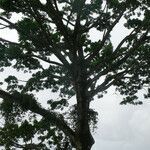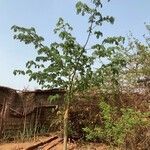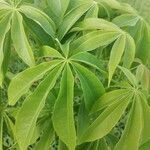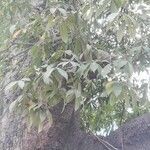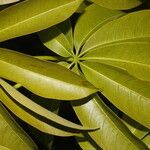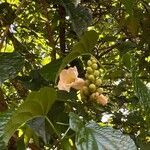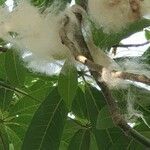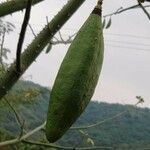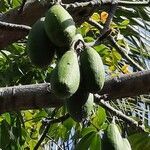Tree up to 40 m. high, the trunk cylindric, often with strong buttresses, 0.8-2 m. in diam., aculeate; or not, the crown spherical to pyramidal, the branches usually aculeate, the bark smooth and fibrous. Leaves 5-to 9-foliolate, glabrous, the petiole 5-23 cm. long; leaflets with a petiolule 0.5-1.2 cm. long, the blade oblong-lanceolate, slightly narrowed at the base, acuminate at the apex, 10-21 cm. long and 2.3-4.2 cm. wide, the margins sometimes denticulate near the apex. Inflorescences fasciculate, few-to many-flowered. Flowers 2.5-4 cm. long, the pedicel 2.5-3 cm. long, glabrous; calyx campanulate, 4-to 5-lobate and with more or less rounded lobes, 1-1.2 cm. long and 0.9-1.2 cm. wide, glabrous outside, silky-villous inside; petals obovate-oblong, rounded, 2.5-4 cm. long and 1-1.5 cm. wide, light yellow, villous to tomen-tose outside except the base, pubescent near the apex inside; staminal column con-ical, 5-5.5 mm. long, glabrous, the filaments ca. 2.5 cm. long, each bearing 2-3 anfractuose anthers, the anthers 1-thecate; ovary slightly subinferior, globose, glabrous; style filiform at the base, suddenly obliquely enlarged above the staminal column, slightly longer than the stamens; stigma capitate. Capsule subligneous, ellipsoid or fusiform, acute at both ends, 10-26 cm. long and 3-4 cm. in diam., dehiscent or not on the tree, the valves ca. 2 cm. wide; seeds numerous, subglobose, 5.5-7 mm. long and 4.4-5.5 mm. wide; kapok copious, grayish.
Trees to 30 m tall; buttresses small or absent, trunk often sparsely spiny; main branches verticillate, spreading horizontally; young branches spiny. Petiole 7-14(-25) cm, longer than leaflet blade; leaflets 5-9, petiolules 3-4(-10) mm; blades oblong to lanceolate, 5-20 × 1.5-6.5 cm, thinly leathery, glabrous, base acuminate, margin entire or very sparsely and minutely toothed near apex, apex shortly acuminate. Flowers subterminal, solitary or in fascicles of up to 15, produced before or simultaneous with new leaves. Pedicel (1.8-)2.5-5 cm. Calyx (0.9-)1.2-2 cm, adaxially glabrous. Petals pink or white, obovate-oblong, 2.5-4 × 0.7-1.5 cm, abaxially densely white villous, adaxially glabrous. Filaments on staminal tube varying in length; anthers reniform. Ovary glabrous; style 2.5-3.5 cm; stigma rod-shaped, 5-lobed. Capsule oblong, tapering toward tip, 7.5-15(-26) × 3-5(-11) cm, fruiting pedicel 7-25 cm, endocarp leathery, smooth. Seeds globose, ca. 6 mm in diam. Fl. Mar-Apr.
A very large tree with a straight trunk and height of 30-40 m. Trees can be 60 m high and the trunk 8 m around. It has large prickly buttresses near the base. The branches come out horizontally and there is a ring of them around the trunk. The leaves are compound. The leaflets spread out like fingers on a hand, with 5-8 leaflets. They are 5-18 cm long by 2-4.5 cm wide. The leaf stalk is 7-20 cm long. The leaves all fall off the tree (deciduous). Flowers are yellowish white, in clusters near the ends of branches. These hang downwards. A long seed capsule hangs from branches. It is 10-30 cm long. It splits into 5 valves. The seeds are embedded in white or grey kapok.
Leaves 5–9-foliolate (usually 7, very rarely more than 9); petiole up to c. 15 cm. long, glabrous; leaflet-lamina articulated to a ± suborbicular disk at the apex of the petiole, up to 16 × 6·5 cm., narrowly elliptic or oblanceolate-elliptic, acuminate at the apex, cuneate at the base, margin undulate or rarely obscurely toothed near the apex, slightly paler below, glabrous on both sides, with 7–10 pairs of nerves slightly raised above, scarcely raised below, looping within the margin; petiolules up to 0·8 cm. long.
Tree up to 18 m. tall (often much taller outside our area) with horizontally branched crown and very straight trunk; bark pale grey, smooth, with scattered conical spines 1–1·5 cm. long, at least when young.
Branches in different forms without prickles or with obtuse or acutely pointed stout prickles, generally prickly in the young state
Petals rose-coloured or white, c. 3·5 × 0·7 cm., oblong-spathulate, rounded at the apex, tomentose outside, glabrous within.
Capsule c. 8–20 × 4–11 cm., oblong-ellipsoid, valves smooth, brown, the whole filled with a copious whitish silky wool.
Calyx c. 1·5 × 1·2 cm., campanulate, lobed i-of the way down with rounded lobes, glabrous outside, pubescent within.
Flowers white, appearing either when the whole tree is bare or on leafless branches
Flowers in axillary fascicles of 1–3; peduncle 2–3 cm. long, glabrous.
Staminal tube c. 5 mm. long; phalanges of 2–3 filaments c. 2 cm. long.
Fruits in some forms bursting on the tree, in others often falling
A tree, up to 200 ft. high, in forest and planted by villages
Seeds many, c. 6 mm. in diam., dark brown, subglobose.
Ovary glabrous or nearly so; style c. 3·3 cm. long.
Trunk with large buttresses
Floss white or grey.
